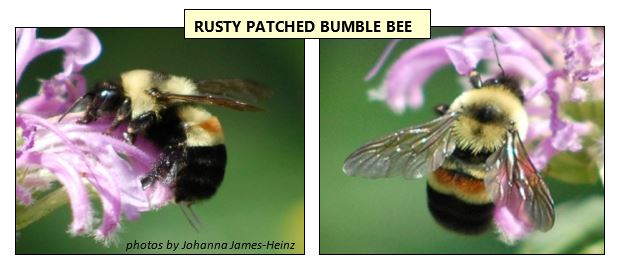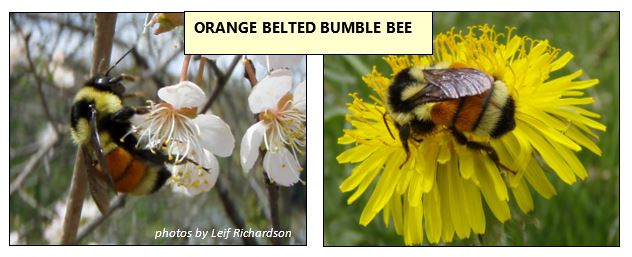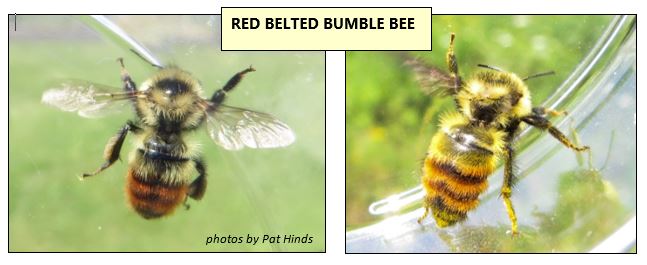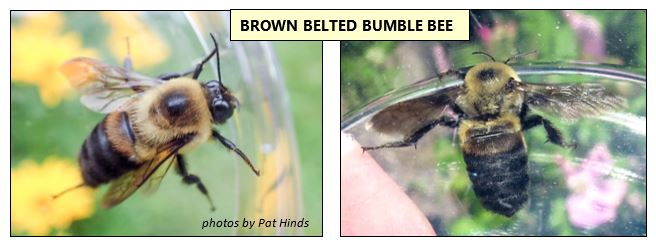August 6, 2021 at 9:53 am
Maine Department of Inland Fisheries and Wildlife is looking for rusty patched bumble bees and you can help!
With a 90% decline in numbers and range since the 1990’s, the rusty patched bumble bee (Bombus affinis) is the first bumble bee protected by the Endangered Species Act. Bees are among the most important pollinators, pollinating two thirds of the food we eat, ensuring food security and healthy ecosystems. To help protect them, we need to better understand where they live in Maine.
If you see a rusty patched bumble bee, snap a photo and send it to iNaturalist where a group of experts can confirm the identification.
How to Identify Rusty Patched Bumble Bees

Worker and Male Rusty Patched Bumble Bees
Male and workers emerge in late May and early June and are likely present throughout the summer.
The first two abdominal segments are yellow, and the rest of the abdomen is black, same as the queens. But both workers and males have a rust-colored “patch” on the upper middle part of the second abdominal segment, bordered by yellow along the sides and bottom.
Queen Rusty Patched Bumble Bees
Queens are likely active from April through early June. By mid-June, the queen remains in the nest to focus on egg laying. In late summer and early fall, newly emerged queens may be active for a short period of time before hibernating for the winter.
Unlike the workers and males, queens do not have a rusty patch! Queens of this species will be very difficult for all but experienced observers to identify in the field. If you rely strictly on color pattern, the first two abdominal segments are all yellow and the rest of the abdomen is black. Unfortunately, this is the same abdominal color pattern as several common species. A key feature to distinguish rusty patched bumble bee from these species is a short malar or cheek space, which gives them a shorter, rounder face than similar species. Unless you are very familiar with bumble bee anatomy, this is not something you are going to be able to distinguish without the help of a microscope.
Rusty patched bumble bees can be easy to confuse with a few other species. We are happy to receive photos of ALL bees you see that you think might be rusty patched bumble bees, and let the experts confirm the species.
Similar Species
Orange Belted or Tricolored Bumble Bee
The orange belted or tricolored bumble bee (B. ternarius) is the most common bumble bee you will see with rust color on its abdomen.
This species is very abundant and found statewide, so you will likely start to recognize it once you begin paying closer attention.
The key distinguishing feature of this bee is that both the second and third abdominal segments are completely orange or rust colored. Rusty patched bumble bees only have a patch of rust color.
Theorange mid-section is bounded by a complete band of yellow above and below, and just the tip of the abdomen is black. Sometimes the orange color is very pale.

Red Belted Bumble Bee
The red belted bumble bee (B. rufocinctus) is an uncommon species in Maine, so you are not likely to come across it often.
A key feature to distinguish the red belted from the rusty patched is the rust coloring is typically confined to the third and fourth abdominal segments, which concentrates the rust on the lower half of the abdomen (rather than the upper middle part of the second abdominal segment).Even though rust coloring can sometimes be found on other segments, there is typically much more of it on the abdomen of a red belted than the isolated small patch on the rusty patched.

Brown Belted Bumble Bee
The brown belted bumble bee (B. griseocollis) is known primarily from the southern half of the state and is not a species that is frequently observed.
Similar to the rusty patched, this species typically has a patch of rust, or more commonly BROWN, in the upper middle half of the second abdominal segment. Unlike the Rusty Patched, the brown patch is bordered by BLACK instead of yellow on the sides and bottom.

Thank you for keeping an eye out and reporting your sightings! Learn more about the Department’s work with invertebrates in the Reptile, Amphibian, and Invertebrate Conservation & Management Report.